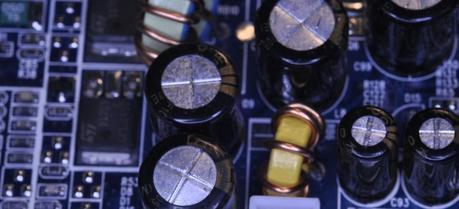 Motherboard voltage regulator capacitors. (Credit: Flickr @ Robert http://www.flickr.com/photos/disoculated/)
Motherboard voltage regulator capacitors. (Credit: Flickr @ Robert http://www.flickr.com/photos/disoculated/)The potential of graphene for batteries becomes more apparent each day, with headlines touting new graphene electrodes and battery materials.
Graphene electrodes
Most recently, researchers at Rice University, which excels in both fundamental and applied graphene research, came out with a prediction that adding some boron atoms to the graphene structure would result in an ultrathin efficient flexible anode for lithium ion batteries. The addition of boron helps the lithium ions of the battery stick better to the graphene anode, which was a problem with some earlier designs of graphene anodes.
Graphene anodes result in faster battery charging and discharging compared to conventional anodes. The research on the boron-graphene mixture was performed together with Honda, who aim to use graphene in batteries for electric cars. Kia and Hyundai have also shown interest in graphene for electric vehicles, all showing that industrial applications of graphene are not very far away.
Already some years ago, engineers at Northwestern University have shown that graphene anodes hold energy better than graphite anodes, with 10x faster charging. In lithium ion batteries, the charge-carrying lithium ions circulate from the lithium fuel cell through the anode and cathode, giving away their charge to power the battery. Charging reverses the process, leading to freshly charged lithium ions. The performance of the battery depends on the ability of the anode to hold lithium ions.
Traditional graphite anodes are solid, with lithium ions accumulating around the outer surface of the anode. Engineering the anode to produce pathways for lithium is possible, however graphene offers a much more elegant solution. Researchers at Northwestern, and others after them, have punctured tiny holes in graphene sheets. The holes are 10-20 nm big, allowing for lithium ions to pass through. In an anode that consists of multiple graphene sheets, the lithium ions migrate through the sheets and permeate the anode, providing for optimal use of storage area and ease of extraction of electricity. The resulting battery can store 10 times more power than ones that utilize graphite anodes.
Last month, Rice University featured once again in the graphene spotlight. This time, researchers have shown that graphene mixed with vanadium oxide in an industrially scalable process leads to cost-efficient superb-performance cathodes. The batteries made with such cathodes recharge in 20 seconds and retain more than 90% of their capacity even after 1000 cycles of use. The process involves cooking vanadium pentoxide, an inexpensive material, together with graphene oxide nanosheets in water. The nanostructures required for the cathode spontaneously form during the cooking process, bringing scalability and mass production within reach. Graphene oxide is one of the products that Graphenea excels in, available in large quantities and at low cost.
Graphene supercapacitors
Finally, graphene is not only being used for the electrodes of batteries, but for the active material itself. Graphene makes such a good battery material that the devices are called “supercapacitors”, i.e. batteries which hold enormous power and charge within a few seconds. Already two years ago graphene supercapacitors that store as much energy as nickel metal hydride (Ni:MH) batteries were demonstrated. An in February this year, UCLA researchers caused shock waves when they showed a graphene mixture that can be coated onto the surface of a regular DVD. An ordinary DVD burner is then used to inscribe millions of supercapacitor circuits into the graphene layer. The layer can later be simply peeled off and transferred anywhere where a superpowered battery is desired.
With such development, we might soon see ultrathin flexible batteries which charge in less than a minute and could be integrated into clothes, paper, car dashboards or just about anywhere you want them.
Graphene solar cells
Graphene’s use for energy does not stop at battery materials, but reaches towards solar cells as well. Researchers in India have shown that graphene stacks can be made into good antireflection coatings for solar cells. Reflection of sunlight at the surface of solar cells is one of the big issues facing the solar industry, alongside the efficiency of coupling light to the active layer of the cell. With graphene stacks, reflectance near the ultraviolet part of the solar spectrum is reduced from 35% to just 15%, saving much energy. The graphene stacks operate like traditional anti-reflection coatings, effectively pushing light that would otherwise be reflected into the active layer of the cell.
Graphene is only a few years young, and is already living up to its promise of changing our world. One of the first applications to make it big will be graphene for batteries and supercapacitors. You can also read more about graphene applications in energy in our recent review.
This article was originally posted on Graphenea by Marko Spasenovic.

